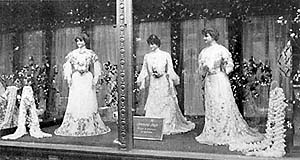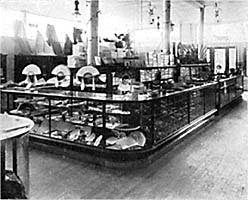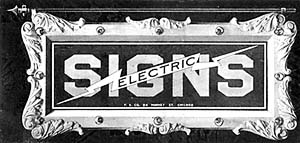In 1901, poised on the threshold of the Twentieth Century, the world looked toward the future with hope and optimism. But even the most forward-looking could not have visualized the enormity of change that lay ahead.
The turning calendar would bring progress and an age of enlightenment, offering broader educational opportunities, greater access and mobility and extended avenues of communication. During the second half of the 19th Century following the Civil War, a new and distinct culture was born – business-oriented and commerce-driven. The Industrial Revolution was in full gear. We had evolved from an agricultural society into a manufacturing powerhouse. And in society at large, as the 1800s were giving way to the 1900s, necessity was yielding to desire.
Changing attitudes and emerging technologies sparked new approaches to mercantile design. In the previous century, little thought had been given to the aesthetic arrangement of merchandise or the visual appeal of the store. Goods were haphazardly displayed in disorganized stacks, piles and bunches. Merchandise was typically hung on pillars or draped over railings, and that which wasn't strewn across walls was often hidden in wooden drawers, out of sight and reach. The term “customer friendly” did not apply.
An 1887 description of Wanamaker's grand emporium in Philadelphia read: “The walls and pillars are gaily decorated with the goods in the store wrought into fanciful designs…Hanging from the second floor of the transept dome are specimens of the upholsterer's work. A plush embroidered piano cover hangs from the railing, attracting the eye from below.” Even when the goods were hanging or strewn attractively, as in the Wanamaker's description, there was little attempt to create enticing merchandise set-pieces, or to make the shopping experience at all efficient for the customer.
Philosophies, however, were changing as merchants stared into the face of the new century. Contemporary store designers speak of “welcoming” customers into the environment. As Twentieth Century merchants developed their selling skills, customers flocking to new establishments were now “invited” into stores with a single architectural gesture: The doorstep was dismantled. Said The Dry Goods Economist of the time, “A step at the entrance is a mistake. No hindrance should be offered to people who may drift into the store.”
Advertisement
Retailers searched for other ways to make access into stores easier. Enhancing customer traffic, aisles were widened and outdated swinging doors replaced with revolving doors. The great merchants made every effort to increase the number of entrances from the sidewalk. John Wanamaker boasted that no other large store in the world had as many entrances as his Philadelphia establishment.
Today, retailers carefully develop fluid traffic patterns and effective means of “vertical circulation.” With the advent of the large department store, merchants of 100 years ago also endeavored to promote movement, ensuring full exposure to all the merchandise they offered. In 1900, the architecture firm of William H. Hume & Son was commissioned to design the new granite and limestone Simpson Crawford & Simpson store in New York, catering to an affluent carriage trade. A notable component of this fashionable establishment was the Otis Escalator, the first of its kind on New York's bustling Sixth Avenue. Merchants soon learned to strategically position the newfangled “moving stairs” so as to steer movement past more expensive and desirable merchandise. The Industrial Revolution had struck! It would strike again.
The Simpson Crawford & Simpson store featured unusually large show windows, now graced with mannequins, often constructed of papier-maché and wax.
The mannequin created a type of voyeurism, isolating a moment in time and etching it into the mind and psyche of the viewer. Mannequins moved emotions and induced a sense of desire in the shopping public. They also created an indelible link between art and merchandising. Marcel Proust described fashion and one of the earlier creations: “…but as for her body, which was admirably built, it was difficult to perceive its continuity…first the blouse protruded like an imaginary belly and ended abruptly in a point, while below it the double skirts ballooned out, making women look as though they consisted of separate parts that had been badly fitted together…”
Better-designed, more realistic mannequins were yet to come. But this quintessential silent sales force was already capturing the imagination of shoppers in the early 1900s. If retail design bookmarks society's place in time, then the evolution of the mannequin is a symbol of a glorious history. As society evolved with the Twentieth Century, so too did the mannequin.
So too would retail design.
Advertisement


 Headlines1 week ago
Headlines1 week ago
 Photo Gallery1 day ago
Photo Gallery1 day ago
 Headlines2 weeks ago
Headlines2 weeks ago
 Headlines2 weeks ago
Headlines2 weeks ago
 Sector Spotlight1 week ago
Sector Spotlight1 week ago
 Headlines1 week ago
Headlines1 week ago
 Headlines1 week ago
Headlines1 week ago
 Headlines2 days ago
Headlines2 days ago
















